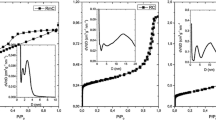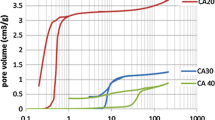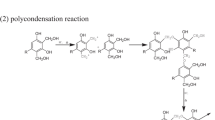Abstract
A classical approach to the production of carbon aerogels by pyrolysis of organic resorcinol–formaldehyde aerogels has been studied. Organic aerogels with a density of no more than 0.17 g/cm3 and a specific surface area of up to 632 m2/g have been obtained. The corresponding carbon aerogels had a density of no more than 0.20 g/cm3, while their specific surface area reached 757 m2/g. The effect of important synthetic parameters—the concentration of the catalyst and the aging time of the precursor gel—on the features of the porous structure and the value of the specific surface area is demonstrated. For the first time, such an effect has been studied in detail for the size distribution of meso- and micropores.




Similar content being viewed by others
REFERENCES
Chandrasekaran, S. et al., J. Mater. Res., 2017, vol. 32, no. 22, pp. 4166–4185.
Gan, G. et al., Eur. J. Inorg. Chem., 2019, vol. 2019, no. 27, pp. 3126–3141.
Pekala, R.W., J. Mater. Sci., 1989, vol. 24, no. 9, pp. 3221–3227.
Fung, A.W.P. et al., J. Mater. Res., 1993, vol. 8, no. 8, pp. 1875–1885.
Pekala, R.W. and Schaefer, D.W., Macromolecules, 1993, vol. 26, pp. 5487–5493.
Kashyap, S., Kabra, S., and Kandasubramanian, B., J. Mater. Sci., 2020, vol. 55, no. 10, pp. 4127–4156.
Kharissova, O.V. et al., Ind. Eng. Chem. Res., 2019, vol. 58, no. 36, pp. 16258–16286.
Bong, S. and Han, D., Electroanalysis, 2019, vol. 32, no. 1, pp. 104–111.
Rodriguez, N. et al., J. Non-Cryst. Solids, 2019, vol. 522, p. 119554.
Aghabararpour, M. et al., J. Nanopart. Res., 2019, vol. 21, art. no. 178.
Yin, C.Y., Aroua, M.K., and Daud, W.M.A.W., Sep. Purif. Technol., 2007, vol. 52, no. 3, pp. 403–415.
Funding
The work was supported by the Russian foundation for Basic Research (project no. 18-29-06036_mk) and the Ministry of Science and Higher Education of the Russian Federation.
Author information
Authors and Affiliations
Corresponding author
Additional information
Translated by G. Kirakosyan
Rights and permissions
About this article
Cite this article
Elmanovich, I.V., Rubina, M.S. & Abramchuk, S.S. Textural Features of Organic and Carbon Aerogels Obtained Using Different Parameters for the Resorcinol–Formaldehyde Precursor-Gel Formation. Dokl Phys Chem 493, 123–126 (2020). https://doi.org/10.1134/S0012501620080011
Received:
Revised:
Accepted:
Published:
Issue Date:
DOI: https://doi.org/10.1134/S0012501620080011




